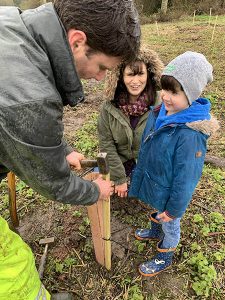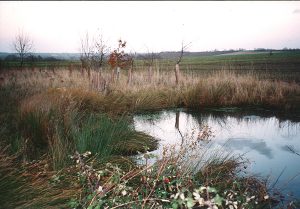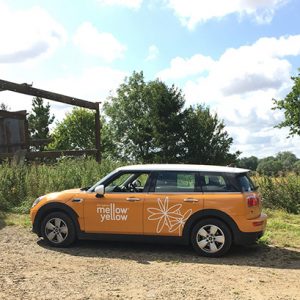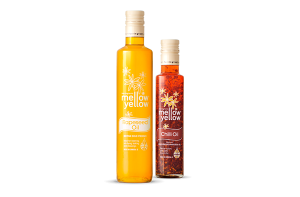On a very wet Sunday in February, with Storm Dennis doing his best to ruin the weekend, we were joined by 30 local volunteers in waterproofs and wellies to tackle climate change head on for our tree planting day.
Trees are the lungs of our planet, they absorb carbon, fight flooding, reduce pollution, nurture wildlife and enhance the beautiful English countryside. Since 1987, we have planted over 8,000 trees on the farm and this time, we thought we would ask the local community for their help with our next tree planting effort.

With the support of The Woodland Trust, we were advised to choose trees that suited the wet conditions of the area the trees would be planted in. They suggested hawthorn, crab apple, hazel, goat willow and holly, which will grow to create a wild wood area. We bought the trees from The Woodland Trust, they sell small saplings that are UK sourced and grown to help prevent the spread of trees diseases and pests. By buying trees from The Woodland Trust, it helps support the fantastic work they do in protecting, restoring and creating the UK’s woodlands. To buy your own trees from The Woodland Trust, visit their shop here.


To start the day off, all our volunteers gathered in our grain store and were served delicious tea and coffee from local coffee roastery, No. 13 Coffee. They roast their own beans in nearby Kettering and then serve their coffee from a converted horse box, which is solar powered! Eli Farrington made a wonderful selection of cakes, all using Mellow Yellow Rapeseed Oil. With everyone settled with a hot drink and slice of cake, Duncan explained why planting trees is so important and the correct tree planting technique. Then it was time to head out into the rain. Armed with spades and umbrellas, we handed out the saplings and our trusty volunteers got digging!
By the time all the trees were in the ground, everyone was pretty wet and cold, so we went straight back to the grain store to enjoy another hot drink from No. 13 Coffee and another slice of cake, after all, we had earned it!

The weather didn’t dampen anyone’s spirits and we hope all our volunteers had a nice time. Trees absorb carbon dioxide all their life, but are most efficient during their teenage to middle age years. So for the next few years, these trees will focus on growing and then in about 10 years, will start really making a difference to global atmospheric carbon dioxide levels. Planting trees is a true investment for the future of our planet, so we are incredibly grateful for all our volunteers and the help they provided! If you want to learn more about why planting trees is so important, have a read of this blog post.
If you want to plant your own trees or attend a tree planting day, visit The Woodland Trust’s website.
I think I might be a Tree Hugger.
I have always appreciated the beauty of and adaptability of trees, whether this be an individual tree impressively showing its unique beauty in the open countryside or adding a warmth of texture to the architectural lines of an urban setting. Together trees make the copses and woodlands that characterise our British landscape, creating our ‘green and pleasant land’. 13% of Britain is covered in woodland, up from just 5% at the beginning of the last century when the Forestry Commission was established. Britain also has an exceptional number of ancient trees compared to the rest of Europe, these trees are a living history, wrapped up with mythology and traditions stretching back thousands of years. Trees provide a home for other forms of wildlife from lichens and fungi, to insects, birds and small mammals. They are also a valuable source of food for wildlife and humans alike, as well as timber having many uses; from being a fuel or an important raw material to build everything from ships and buildings, to fine furniture to the more mundane but essential: paper for toilet rolls.

As a young boy I can just about remember the grand knarled Elm trees around the farm, most of which succumbed to the devastating Dutch Elm Disease which just about wiped this species out. Luckily, a few Elms survived which are resistant to the disease, but this is now a rare sight. From the 1980s, farmers started to be encouraged by government policy to plant trees on their farms to replace the former trees that had been lost over the years from Dutch Elm disease and from those pulled out following the second World War, where government policy had encouraged farmers to grow more food ensuring Britain was never held hostage to food shortages again.

Over the years, my father and I have planted well over 8,000 trees on our farm. Father started this in 1987, establishing two small copses of native deciduous hardwoods and fruiting trees in awkward field corners. Now some thirty years later, these trees have added real beauty to the landscape, as well as providing habitat and food for wildlife. From autumn 1989, as soon as I left school, I planted my first trees on the farm and spent many subsequent winters with a spade and flask of tea planting trees and hedges around the farm. Over the years, these have needed weeding, tending and replacing ones that either died in summer droughts, or were eaten by Muntjac and hares. But now as they grow and mature, I find real pleasure in seeing them evolve, becoming part of the landscape.

When I first started planting trees and hedges on the farm, my motivation was to improve the visual character of the farm, by creating a network of small copses linked by hedgerows next to water courses or across fields. For example, I created a beetle bank across our largest field and planted it with a mixture of tree and hedge plants. This created a wildlife corridor from an old hedge at one end to a small copse at the other. Over the years it has provided habitat for Grey Partridge and other farmland birds, as well as small mammals and insects, including of course beetles. It is visible from a nearby bridleway, providing an interesting focal point on the horizon.
In addition to the visual and wildlife benefits, many of the trees we have planted such as English Oak, will in time be a source of quality timber, however this will be long after I have gone. But I have also planted a couple of areas of Poplar trees purely for their timber around twenty years ago. This is a quick growing hardwood which takes around twenty five years to mature. So these will soon be ready to cut down to make pallets or furniture frames, following which we will replant the areas with more trees in their place to start the cycle over again.
Since I started planting trees on our farm as a way of improving our own little part of the countryside, the appreciation of trees in the wider world to reduce flooding and soil erosion has become more apparent. However, the biggest change over the last decade has been the wider realisation of the ability of trees to absorb carbon dioxide from the atmosphere and the sense of despair at the continued global deforestation, especially in the Amazon basin, often thought of as the planet’s lungs. Admittedly the 8,000 trees we have planted is not going to make up for vast tracts of lost rainforest, but every little bit genuinely helps.

Trees absorb carbon dioxide all their lives, but are most efficient during their teenage to middle age years. Therefore, the trees we planted between 1987 to around 2005 are currently doing a very good job for us. According to the Farm Carbon Toolkit every hectare of broadleaved deciduous trees will absorb around 4,761Kg of carbon dioxide per year. In addition, for every 1,000m of managed hedgerow, a further 1,175 Kg of CO2 is absorbed every year. On our farm we have doubled the area of woodland over the last thirty years to over 9 hectares and increased the length of hedgerows to over 14,000m, so our woodland and hedgerows are absorbing over 59 tonnes of CO2 every year.
(To learn more about how plants store CO2 in the soil, have a read of our blog post about why we no longer plough our fields.)
To put this into perspective, an average family car such as our ‘Mellow Yellow Mini’ produces around 117g of CO2 for every kilometre driven, therefore our trees and hedges are removing enough CO2 out of the atmosphere every year to offset over half a million kilometres of driving, which is enough to remove over 40 ‘Mellow Yellow Minis’ off UK roads each year (for the average car use of 11,900 km per year).

With all these great benefits that trees bring to our lives and the world around us, we are certainly going to continue planting trees on our farm. Starting this February, working with the Woodland Trust, we are going to plant up a small area next to a pond with 100 trees, that until recently had scrub and dead elms. This time though, rather than doing all the work ourselves, we are going to invite local people to help us. We will provide the young trees and in return for everyone’s hard work, we will lay on some refreshments to create a real good community spirit. If you would like to join us and plant a tree on Bottom Farm on Sunday 16th February, register for your ticket here.
So yes, I am definitely a Tree Hugger and proud to be called one! Any other prospective tree huggers out there, feel free to sign up to come along in February and plant your very own bit of history in the English countryside.


 Oils
Oils Rapeseed Oil
Rapeseed Oil Chili Oil
Chili Oil Dressings
Dressings Classic Vinaigrette
Classic Vinaigrette Balsamic Dressing
Balsamic Dressing Honey & Mustard
Honey & Mustard Chili & Cumin
Chili & Cumin